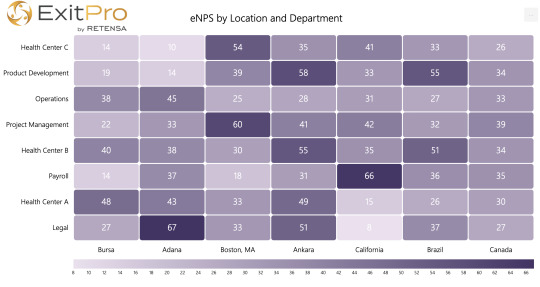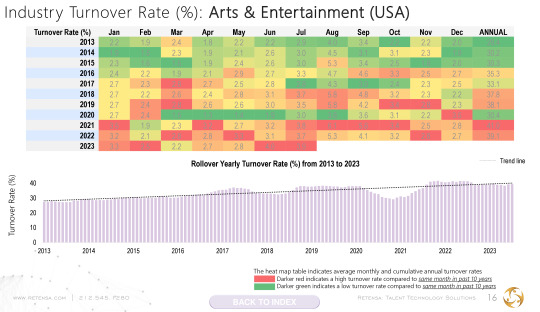ExitPro exit interview software: Survey templates to predict turnover. Customize exit interview questions and reports in 21 languages for 50-50,000 employees. Site: exitpro.com
Don't wanna be here? Send us removal request.
Text
0 notes
Text
Looking for a comprehensive guide on employee retention and exit surveys? Our blog provides valuable resources to address all your questions. Explore our insights on essential exit interview questions, tips for outsourcing exit interviews, best practices for conducting exit surveys, and much more. Enhance your understanding and strategies for effective employee retention and exit management.
0 notes
Text
0 notes
Text

ExitPro’s exit interview software provides a report of “eNPS by Locations and Department”, it represents various locations where the company operates, offering a comprehensive view of the employee net promoter score (eNPS) across different branches and departments. This visualization enables companies to assess employee sentiment and advocacy levels within each location and department.
By categorizing eNPS scores based on location and department, organizations can identify areas of strength and areas that require attention.
Furthermore, the visualization facilitates comparisons between different locations and departments, enabling organizations to benchmark performance and identify best practices that can be replicated across the company.
Overall, the visualization of eNPS across different locations and departments provides valuable insights into employee sentiment and helps organizations make informed decisions to enhance the employee experience and drive organizational success.
0 notes
Text

In Retail, attracting and retaining talent is a constant challenge amidst labor shortages and evolving consumer demands. High turnover rates persist, driven by factors like schedule flexibility and online competition. Retailers combat this with competitive wages, training, and tech integration. Exit interview software helps capture employee needs, aiding in strategic retention efforts. With these insights, retailers can adapt recruitment and retention strategies, ensuring long-term success in this competitive landscape.
#exit interview software#exit survey#ExitPro#employee turnover trends#employee retention#industry turnover rate
0 notes
Text

Looking for expert guidance on conducting exit interviews? Our seasoned exit interview expert offers tailored advice and strategies to maximize the value of these crucial conversations. With years of experience in HR and employee retention, our expert provides practical insights on how to navigate exit interviews effectively, ensuring that both employers and departing employees benefit from valuable feedback. Whether you're seeking tips on asking the right questions, handling sensitive topics, or interpreting responses, our expert is here to support you every step of the way. Reach out today for personalized assistance and enhance your exit interview process.
0 notes
Text

In the public sector, which includes federal, state, and local government agencies, workforce trends are shaped by a mix of challenges and opportunities. While government jobs offer stability with competitive benefits and job security, turnover is influenced by factors like budget constraints and political changes. There's a focus on attracting and retaining a diverse workforce due to retirement trends, alongside adapting to remote work expectations accelerated by the pandemic. Prioritizing diversity, equity, and inclusion, investing in professional development, and modernizing recruitment processes are key strategies for retaining talent in government organizations. Aligning turnover drivers revealed in exit interviews with the attractors of public service can target individuals seeking meaningful work post-"Great Resignation," while fostering an inclusive culture and adapting to modern workforce expectations enhances government agencies' ability to attract and retain employees. Get a free exit survey from ExitPro to improve retention in the government sector: https://exitpro.com/
0 notes
Text

The Entertainment and Performing Arts industry witnessed notable trends in employee retention and turnover. Despite the industry's dynamic and creative nature, it faces unique challenges that impact workforce stability. High turnover rates occur, as freelancers and project-based roles represent the preponderance careers, contributing to a fluid and ever-changing labor landscape.
Factors influencing turnover in the Arts & Entertainment sector include the largest union renegotiations affecting writers and actors, the rise of Artificial Intelligence, the project-based nature of work, and the pursuit of diverse artistic opportunities. Professionals in the industry often seek creative autonomy, consistent projects, and opportunities for skill development, making employee retention a complex challenge.
Organizations will succeed to retain creative talent that prioritize inclusive and supportive work cultures, offer opportunities for professional growth and provide fair long-term compensation packages. Additionally, the rise of remote work has introduced new dynamics to talent retention, with flexibility becoming a key factor for many in the industry.
As the Arts & Entertainment industry continues to evolve, employers adapt retention strategies to address these trends, placing greater emphasis on fostering positive workplace culture, offering stability in work, and providing meaningful opportunities for career advancement. Effectively predicting staff turnover with exit interview software will be crucial for organizations looking to attract and retain top talent in this vibrant and creative field.

#Arts & Entertainment#exitpro#exit survey#exit interview#employee retention#exit interview questions#exit interview software#employee turnover#exit interviews#turnover analysis#exit interview tips
0 notes
Text

Step into the dynamic realm of manufacturing, where skilled workers drive production forward. From cutting-edge technology to aerospace advancements, this industry grapples with recruitment and retention challenges amidst automation and fluctuating global demand. Explore how forward-thinking manufacturing plants prioritize workforce development and employee well-being, cultivating a resilient workforce poised for success.
The modern manufacturing landscape is characterized by an emphasis on innovation, efficiency and agility. Organizations that foster a positive work culture, prioritize employee wellness, and provide opportunities for career growth experience higher retention rates. The best exit interview software will address retention and turnover drivers across age, tenure, departments and locations to retain a skilled and adaptable workforce. By aligning exit interview questions with the changing needs of modern plant employees, manufacturers can position themselves as an attractive employer for stable long-term success.
#Manufacturing turnover trends#ExitPro survey#employee turnover#employee retention#turnover analysis#report#employees#exit survey
0 notes
Text

As the Arts & Entertainment industry continues to evolve, employers adapt retention strategies to address these trends, placing greater emphasis on fostering positive workplace culture, offering stability in work, and providing meaningful opportunities for career advancement. Effectively predicting staff turnover with exit interview software will be crucial for organizations looking to attract and retain top talent in this vibrant and creative field.
#Arts & Entertainment industry#retention strategies#positive workplace culture#exit interview software#attract and retain top talent
0 notes
Text

In the volatile realm of the Finance industry, employee retention and turnover trends are shaped by a blend of economic, technological, and demographic factors. As a sector that demands specialized skills and expertise, maintaining a stable workforce is a focal point for financial and insurance institutions. Turnover trends among finance workers are often influenced by the competitive nature of the industry, where professionals may be enticed by offers from rival organizations or venture into entrepreneurial pursuits. The emergence of fintech and the digital transformation of financial services increased demand for finance employees with cutting-edge technological skills, contributing to financial manager and financial advisor turnover as companies vie for top talent in this space.
Retention efforts in the Insurance sector often revolve around competitive compensation packages, performance incentives, and opportunities for professional growth. Insurance companies that invest in employee development, foster a collaborative work culture, and adapt to flexible work arrangements prove successful in retaining valuable actuarial and compliance staff. The demographic shift and changing expectations of the workforce, particularly among younger generations, have led financial organizations to emphasize factors beyond traditional compensation. Initiatives promoting diversity and inclusion, as well as a commitment to corporate social responsibility, are increasingly integral to comprehensive loan officer and accountant retention strategies.
As the Finance industry continues to navigate global economic shifts and technological advancements, with real-time employee insights remain paramount. Employers can address analyst turnover trends through a multifaceted approach that encompasses skill development, work culture enhancement, and aligning with evolving workforce expectations using exit interviews to predict employee turnover. Done correctly, financial institutions can position themselves for sustained talent supply in a competitive landscape.
0 notes
Text

Turnover rates in the Construction industry can be influenced by the ebb and flow of projects, seasonal variations, and the availability of skilled labor. Unless in a major recession, skilled workers are consistently in high demand. Skilled construction worker mobility between projects and employers contributes to fluctuations in turnover. Infrastructure and real-estate growth conditions also impact long-term employee retention prospects. Organizations that prioritize workforce development, invest in training programs, and offer competitive compensation packages prove more successful in retaining skilled construction workers. The accelerating adoption of technology and innovation in building processes has led to a demand for workers with up-to-date skills, further emphasizing the importance of ongoing training and development initiatives.
As the Construction industry continues to evolve, addressing these trends is crucial for employers aiming to maintain a stable and skilled electrical, plumbing and carpentry workforce. Construction companies that implement exit interview software that capture employee well-being, professional development and adaptability, can reduce construction worker turnover and navigate the challenges inherent in this challenging industry.
0 notes
Text
In this exit interview expert article, we will look at the main types of exit interviews, who should conduct exit interviews, and when to use that exit interview type and when to avoid it.
0 notes
Text
0 notes